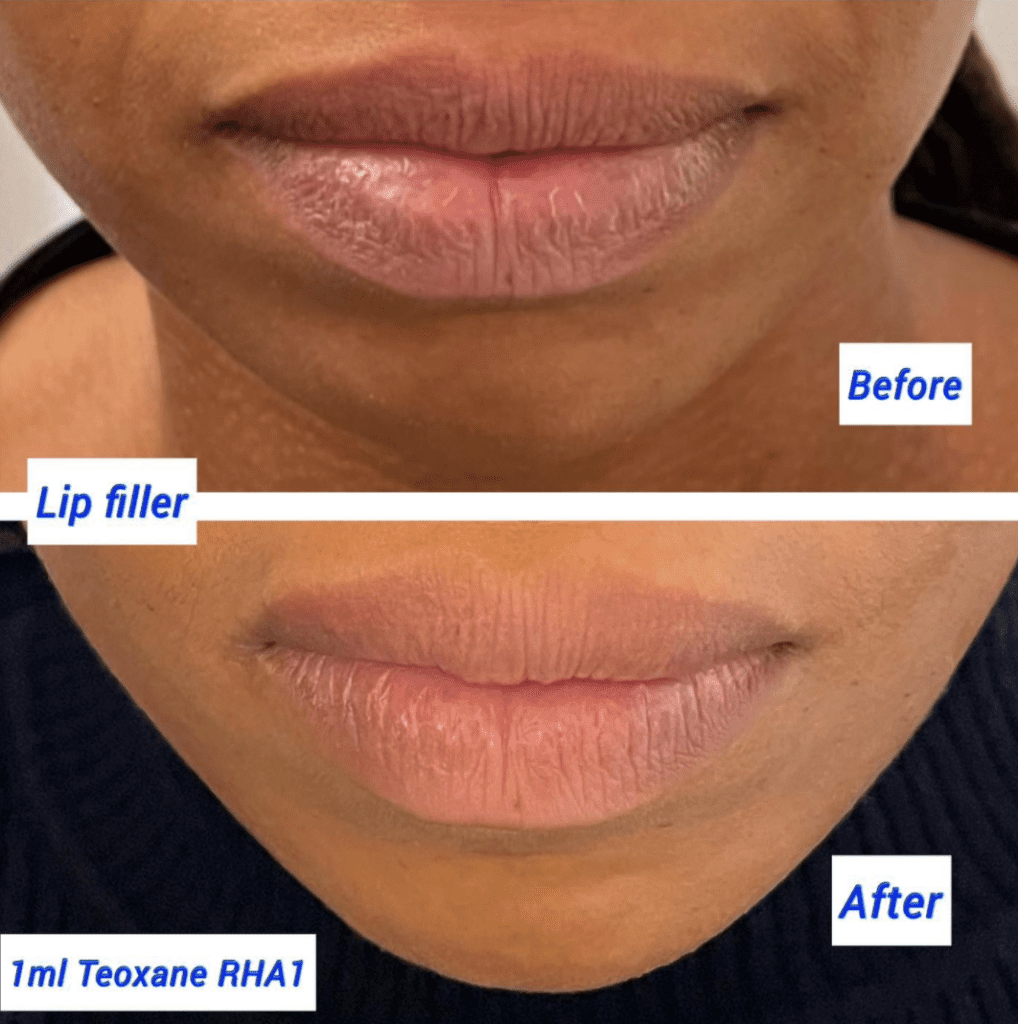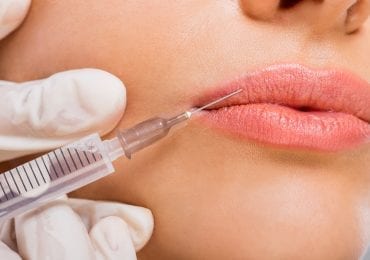When researching fillers, you may have come across horror stories online about “migrated filler”. Because fillers are more and more popular, there is an increased risk of things going wrong if you are in the wrong hands. Let’s talk about what causes lip filler to migrate and what to do about it.
What is Filler Migration?
Filler migration is the process of the filler migrating to another area other than the injection site. Whilst you often talk about filler migration in lip fillers, the filler can migrate in several injection areas, including the cheeks and jawline.
It’s important to know that while filler migration is possible, it is rare. Although filler migration isn’t common, the chances of experiencing it are higher when you choose an unqualified or inexperienced injector.

Do You Have Migrated Fillers?
In lip filler, when the filler has migrated, you can see what is called “duck lips” or “trout-pout”. It looks like a little shelf above the lips. In the tear-trough area, you would see little lumps and ridges in the lower eye area. Most of the time, if your filler has migrated, it is noticeable. It’s important to know that the filler isn’t moving to different parts of the body. Filler migration refers to a small millimetre of movement.
What Causes Lip Filler to Migrate?
There are several factors that are thought to cause filler migration:
- Inexperienced injector – the world of aesthetic treatments is widely unregulated in the UK. That means that someone can legally inject filler without the right level of experience and knowledge. If you don’t know about the structure of the skin, the filler can be placed incorrectly or too deeply.
- Poor injection technique – if you are in the wrong hands, an incorrect or poor injecting technique can increase the likelihood of filler migration.
- Overfilling – if you use too much filler and overfill, it may increase the risk of filler migration. In the case of lip filler, when too much filler is injected, the filler has nowhere else to go except to spill out.
- Using the wrong product – not all cosmetic fillers are the same. Using the wrong product increases the risk of it shifting beyond the placement area. Your doctor needs to use the appropriate filler to ensure it stays put.
- Inflammation – Inflammation occurs when a foreign substance is injected into the face. An inflammatory response isn’t a common reason for filler shifting as a poor technique or use of too much product, but it still occurs in some instances. You may have temporary inflammation, swelling or at the treatment site, causing the filler to migrate.
How Do You Fix Filler Migration?
What happens when your filler migrates. Is there a way to fix it? There are two ways to fix migrated filler:
- Dissolve with hyaluronidase
- Allow the filler to break down and dissipate on its own
The quickest way to deal with filler migration is to dissolve with hyaluronidase. Hyaluronidase is an enzyme that breaks down the hyaluronic acid gels that make up most fillers. In a few hours, the enzyme softens the filler returning the treatment area to a more natural shape, size, and projection.
You don’t need to dissolve all the filler if only one or a few areas show signs of migration. Depending on the amount of migration, some areas, like the lips, may need to recover first before injecting them again. For most patients, that means waiting 4 to 6 weeks. If you dissolve and refill your lips, ensure you go slow and avoid overfilling the second time.
Fillers naturally degrade for those who want to wait it out. However, this is a much longer process, and there’s a chance that your body may not break down the product entirely. It can take between 6 to 12 months of waiting. At the same time, choosing this option doesn’t mean that every last drop of the filler will dissipate before you inject again.
UK Non-Surgical Cosmetic Surgery Laws and Regulations
You may be surprised to hear that regulations and laws surrounding non-surgical procedures like fillers and botulinum toxin are yet to catch up with the industry. It’s only from October 2021 that it became a criminal offence to administer botulinum toxin or fillers to anyone under the age of 18 in England. Current regulation means that you don’t need to be a medical professional to administer botulinum toxin , fillers, or other minimally invasive procedures. There is a need for better regulation, but currently, the responsibility is placed on the consumer to do their due diligence.
As a general rule of thumb, there are certain things you should look for in your cosmetic surgery clinic for fillers, including:
- Reviews
- Clinic and doctor reputation
- Products used
- Cleanliness
How to Avoid Filler Migration
The exact cause of filler migration isn’t entirely clear. But there are steps you can take to prevent and avoid filler migration. The skill and experience of the injector are one of the most important factors in getting any type of cosmetic treatment safely. Even though dermal fillers are deemed safe, a highly skilled and experienced practitioner can make all the difference.
When looking for a practitioner, you need to do extensive research. Read client testimonials, look at before and after photos, and ask for your injector’s qualifications and experience. Look for reviews on platforms like RealSelf and TrustPilot, where you can get a good idea of cosmetic surgery clinics and their previous experience.
One of the benefits of getting filler is that you control the amount being injected. Migration often occurs when the area is overfilled. That’s why it’s so important to be aware of the total amount injected. You also need to tell your practitioner exactly how much filler you have previously had in the past. This will help them to determine the best and safest amount of filler to inject.
Make sure your clinic uses trusted brands. The world of fillers is a big one, with many brands trying to break through into the market. The properties of fillers can differ greatly from brand to brand. It’s important that you ask the right questions when you speak to your practitioner to know exactly how each product works.
What Happens If Filler Migration Becomes a Recurring Issue?
Migrating filler can be a one-off experience for some and a constant problem for others. This is something to consider before you inject the areas again. If you are prone to filler migration, consider other cosmetic procedures that don’t involve fillers. These may include:
- Lip lift– A lip lift is a permanent way to enhance your lips’ shape, size and appearance. The procedure shortens the length between the nose and the upper lip, so more of the pink part of your lips shows. A lip lift addresses the shapes of the lips and isn’t the best option if adding volume is your goal.
- Lip flip – The procedure uses neuromodulators rather than fillers. Some doctors, however, choose to combine different injectables. Lip flips are done to improve the shape and size of the lips. When injected, the muscles around the lips relax and flip out, making them appear a little poutier. The technique is ideal for those who have gummy smiles or thin lips.
- Fat transfer – If you don’t want to enhance your lips with injectables, the next best option is fat transfer. Autologous fat adds fullness and volume to otherwise thin lips or those prone to filler migration.
What to Do if You Think You Have Filler Migration
If you think your filler has migrated, there’s no need to panic. Stay calm. A benefit of filler is that it’s a temporary treatment. Over time, your filler will naturally break down and metabolism in the body. That’s not to say you have to walk around with your filler migrated until it leaves the body naturally.
Depending on where the filler is, you have various options. The first step is to not get any more fillers. Whether it’s lip filler or cheek filler, avoid any further filler appointments for now. You can’t improve filler migration by injecting more filler into the area. Filler within your lips or other areas can be dissolved. You should then wait at least 2 weeks before having any more filler.
Harley Street Fillers at The Harley Clinic London: What to Expect
The bottom line is that the best way to prevent filler migration is by choosing a reputable clinic and practitioner. You need someone with the knowledge, experience, and qualifications to create a great natural-looking result. Do your research, look at credentials and be confident that you are in safe hands. After all, fillers can have a big impact on the overall look of your lips and face and you want the best result possible.

By understanding what causes lip filler to migrate, you can put yourself in the strongest position possible to choose the right cosmetic surgery clinic for your treatment. If you’re worried about filler migration or are interested in getting your fillers from a world-class facility on Harley Street, book a consultation today at the Harley Clinic.













